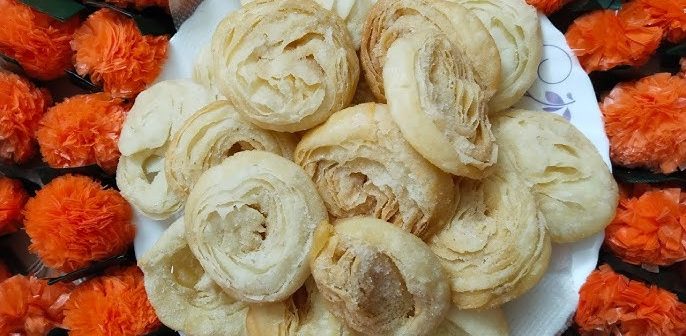Fenori is a layered, crispy sweet delight that holds a cherished place in Goa’s festive celebrations, particularly during Diwali. This traditional Goan sweet features a unique preparation method, resulting in its characteristic flaky and crunchy texture, achieved by rolling and frying layers of dough and then coating them in powdered sugar or, sometimes, immersing them in sugar syrup.
Origins and Cultural Significance
Fenori’s origins are deeply intertwined with Goan and Maharashtrian culinary traditions, where similar versions like Chirote are popular. However, the Goan variant is distinguished by its unique process and presentation, sometimes crafted to resemble roses with food coloring for added appeal. Fenori is a key component of the faraal (a mix of festive snacks and sweets prepared at home), embodying the essence of Goan Diwali.
Preparation and Ingredients
The main ingredients in Fenori are simple: all-purpose flour, ghee, and powdered sugar. The dough is rolled out and brushed with a ghee and flour paste between layers before being tightly rolled, sliced, and shaped into spirals. Each piece is fried to a light golden-brown color, creating a delicate and crispy texture. Finally, a sprinkle of powdered sugar or, in some variations, a dip in syrup completes the treat. Some cooks add subtle flavors like cardamom or use rice flour for dusting, enhancing the layered look and texture.
Variants and Regional Differences
In Goa, Fenori remains predominantly a Diwali treat, though it is similar to other layered sweets across India, like the Maharashtrian Chirote and the South Indian Khaja. Variations in other regions may add jaggery, honey, or additional spices. Some families in Goa prepare brightly colored Fenori to symbolize the vibrancy of Diwali, while in Maharashtra, Chirote is a simpler version without added colors.
Pros and Cons of Fenori as a Festive Sweet
As a traditional treat, Fenori offers a taste of Goan heritage, but its preparation can be time-consuming due to the intricate layering and frying processes. Additionally, while its light, crispy texture makes it a delightful snack, its fried nature means it should be consumed in moderation, especially given its sugar content.
In conclusion, Fenori encapsulates the rich, festive spirit of Goa during Diwali, offering a sweet, flaky experience that generations have enjoyed. As a cultural symbol, it highlights Goa’s culinary creativity, blending simple ingredients with skill to produce an intricate and cherished Diwali treat.





